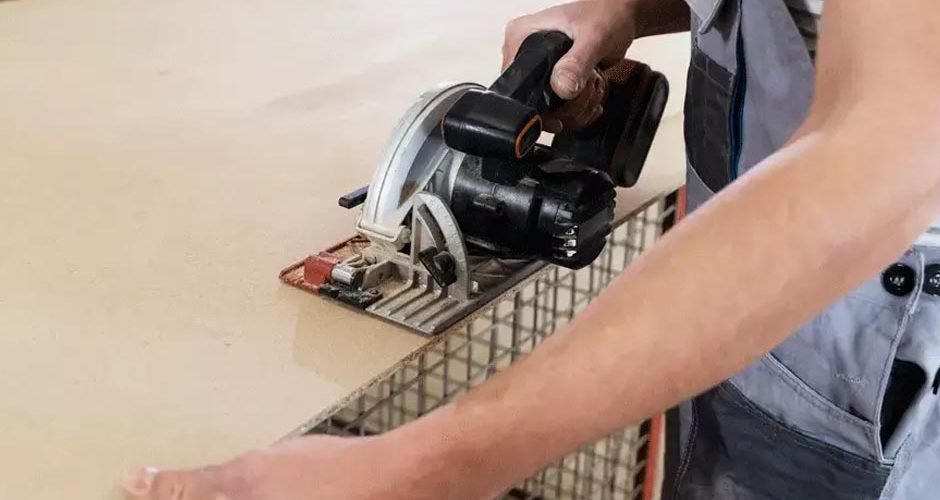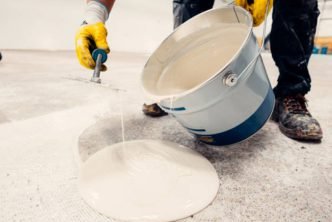MDF is a common material for woodworking projects since it is inexpensive and versatile. Although it tends to produce a lot of fine dust and can easily chip or splinter if not handled properly, it can present some cutting issues.
Table of Contents
Tools for Cutting MDF
Circular Saw
- A circular saw is a small power tool for cutting materials that has a motor, a blade guard, and a circular blade with teeth. It is adaptable and frequently used to cut straight lines in MDF.
- It is advised to use a carbide-tipped blade with at least 40 teeth while cutting MDF. This kind of blade makes cuts that are smoother and less likely to chip.
- Make sure the blade is correctly aligned and set to the required cutting depth before using a circular saw to achieve accurate cuts. For straight and clean cuts, guide the saw along the cutting line using a straightedge or other object.
Jigsaw
- A jigsaw is a handheld power tool that features a reciprocating blade for cutting curves, angles, and intricate shapes in various materials, including MDF.
- Use a fine-toothed blade made especially for cutting wood when using a jigsaw to cut MDF. This kind of blade creates smoother cuts and less splintering.
- Drilling a pilot hole into the MDF is essential before making any curved or complicated cuts. The jigsaw blade can then be inserted and smoothly moved along the chosen cutting path. For accurate results, take your time and pay great attention to the cutting line.
Table Saw
- A table saw is a fixed power tool that projects through a table’s surface and has a circular blade mounted on an arbor. It is frequently used to cut a variety of materials, including MDF, accurately and straightly.
- When cutting MDF with a table saw, security must come first. Always put on the proper protective gear, such as safety glasses and hearing aids. Make sure the anti-kickback pawls and blade guard are installed and working correctly.
- To achieve precise cuts with a table saw, make sure the blade is aligned parallel to the miter gauge or fence. To push the MDF through the blade, use a push stick or push block while keeping your hands far enough away from the edge to be safe. To avoid chipping and splintering, think about utilizing a splitter or a zero-clearance throat plate.
Techniques for Cutting MDF
Measuring and Marking
- Importance of accurate measurements and markings on MDF. Accurate measurements and markings are crucial when working with MDF to ensure precise cuts and proper fitment during assembly. This assures a professional finish and reduces waste.
- Recommended tools and techniques for precise measurements. It is advised to use a good tape measure or a combination square for precise measurements. The MDF surface can also be marked clearly and precisely using marking implements like a pencil or a marking knife.
Straight Cuts
Step-by-step instructions for making straight cuts in MDF.
- On the MDF, measure and indicate the desired cut line.
- Position a straight edge guide along the drawn line, such as a clamped piece of wood or a metal ruler.
- To cut the material, use a circular saw or table saw with a fine-toothed blade, making sure that the blade is parallel to the designated line.
- Use consistent pressure to move the saw down the straight edge while retaining control.
- Properly support the MDF to keep it from drooping or splintering as you near the cut’s conclusion.
Tips for preventing tear-out and achieving clean edges.
- To reduce tear-out, select a premium, sharp blade made especially for cutting MDF.
- To prevent splintering, place masking tape around the cut edge.
- Use a moderate, steady motion when cutting to avoid burning or tear-out from the blade overheating.
- To support the MDF fibers and reduce tear-out, take into account utilizing a zero-clearance insert on a table saw.
Curved Cuts
Different methods to create smooth curved cuts in MDF.
Fine-toothed jigsaw blades should be used to cut following the defined curved line while maintaining control and steadiness.
Make a template of the necessary curvature out of a solid material, such as plywood, and use a router equipped with a flush-trim bit to make clean cuts in the MDF using the template as a guide.
Usage of jigsaw or router for more complex shapes.
Jigsaw is frequently the ideal tool for delicate or complex forms thanks to its mobility and capacity for curved cuts.
However, you can also use a router equipped with a pattern-cutting bit by making a template. Then you can use the router to precisely cut the MDF using the template as a guide.
Joinery Techniques
Butt joints, rabbets, and dadoes are common joinery methods for MDF. These techniques help connect MDF boards securely and create strong and durable joints.
Instructions for creating butt joints, rabbets, and dadoes.
- Butt joints. Two MDF boards should have their edges lined up before applying wood glue to the junction. For increased strength, fasten the junction with screws or nails.
- Cut a groove along the edge of one MDF board using a table saw or router. After that, the second board slides into this groove to form a secure union. As necessary, glue and secure the junction.
- Cut a groove across the face or edge of an MDF board using a table saw or router. Another board can slide into this groove to form a safe junction. Glue and fasten the joint as needed.
Tips for secure and durable connections.
- Ensure proper alignment and tight-fitting joints before applying glue or fasteners.
- For further stability, use clamps to hold the joints together while the glue dries.
- To prevent the MDF from cracking, drill holes in advance for screws or nails.
- To establish a solid bond, use suitable adhesives created especially for MDF.
Safety Tips for Cutting MDF
Personal Protective Equipment
Eye protection is essential since cutting MDF can result in flying debris that could hurt the eyes. Utilizing respiratory masks lowers the possibility of respiratory problems by filtering out the small dust particles produced during cutting. Gloves offer protection from splinters, wounds, and possible contact with hazardous chemicals used in the manufacture of MDF.
Workspace Safety
- Setting up a well-lit and organized workspace. A well-lit workspace ensures better visibility, reducing the chances of accidents. Organizing tools and materials makes them easier to access and lowers the chance of tripping over clutter.
- Clearing clutter and ensuring a stable work surface. To prevent obstructions and potential accidents, clear the workstation of any extraneous things. To avoid movement while cutting, make sure the work surface is solid and locked in place.
Dust Extraction
- Health hazards associated with MDF dust. Fine particles included in MDF dust can irritate the lungs and contribute to respiratory conditions like asthma when inhaled. Additionally, formaldehyde, a recognized carcinogen that causes long-term health hazards, might be present.
- Recommendations for effective dust extraction systems. To efficiently capture and remove the dust from the cutting of MDF, use a dust extraction device. To reduce health hazards, use a system that has a high-quality filter and adequate airflow.
Safe Operation Practices
- Precautions when operating different tools for MDF cutting. Each tool used for MDF cutting has specific safety precautions. For instance, keep your hands away from the cutting line when operating a saw and make sure the blade guard is in place. Use a push stick or guide to keep a safe distance from the spinning bit when operating a router.
- Proper handling of tools, blades, and materials. Always use caution when handling tools and adhere to manufacturer instructions. To ensure safe and easy cutting, keep blades sharp and clean. Use safe lifting procedures when handling MDF sheets to prevent strain or damage.
Conclusion
Cutting MDF safely requires the proper tools, techniques, and safety precautions. To reduce chipping and tear-out, it is crucial to utilize a sharp blade, such as a router bit or a saw blade with a carbide tip.
Additionally, it’s essential to put on the proper protection gear, including safety glasses and a dust mask, to avoid respiratory problems and injuries brought on by MDF dust. Working in an area with good ventilation or using a dust collecting device can both assist cut down on the amount of airborne dust.
Finally, using the right cutting methods, such as making several shallow passes rather than a single deep cut, can improve accuracy and safety when working with MDF.
The safest method for cutting MDF to size is to hire a professional MDF cut to size service like London Furniture Spraying, as only a professional company that does it for several years knows all the safety techniques and follows the rules. Also, a professional team will always have the right equipment that is important to do the work correctly.





